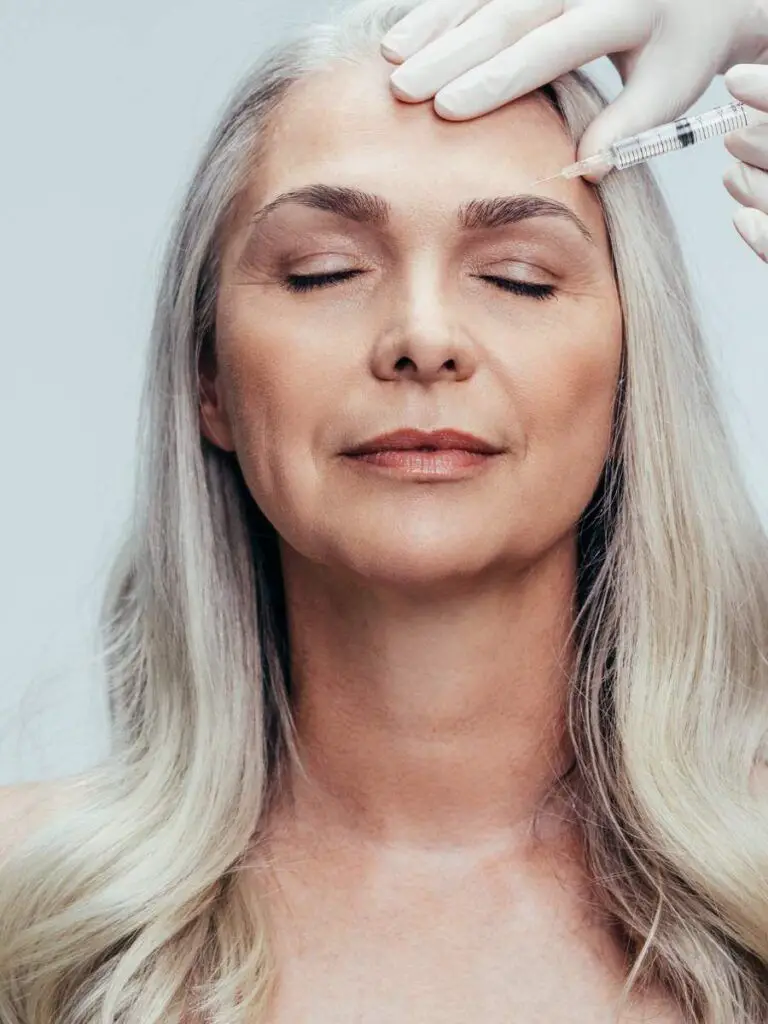As an Amazon affiliate, I may earn from qualifying purchases. Please read our Disclaimer and Privacy Policy.
I always thought the benefits of Botox were for people well into their 40’s or more. Apparently, that’s not the case anymore. I was shocked to learn that young people in their 20’s are starting to get “preventative Botox.”
It will be interesting to see what the long-term effects might be! According to a review in the National Library of Medicine, long-term injections of Botox can cause permanent changes to the facial muscles, resulting in a mask-like appearance.
There was a time when Botox injections were only for the wealthy.
Now, Botox is a household name! You might say it has revolutionized the way we approach aging.
Personally, I’m not convinced. But I certainly understand the pressure to look younger, and it’s definitely less expensive than plastic surgery. In fact, it’s a completely non-invasive solution to soften the appearance of fine lines.
Of course, the benefits of Botox extend beyond it’s use for cosmetic purposes. It can be used to treat muscle spasms, migraines, correct Bell’s palsy, and even stop sweat glands from producing too much sweat. It can even alleviate an overactive bladder.
Keep reading to learn more about the benefits of Botox, potential side effects, and information about the Botox procedure.

How Botox Works
Botox, short for botulinum toxin injections, is derived from the bacterium Clostridium botulinum. When used in small, controlled doses, Botox works by temporarily paralyzing or weakening facial muscles.
By targeting specific facial muscles, Botox temporarily relaxes muscle contractions, effectively reducing the appearance of wrinkles and fine lines.
The Procedure
The first step is a consultation with a qualified healthcare provider. It’s usually a dermatologist or plastic surgeon. During the consultation, the provider will discuss your concerns, assess your facial anatomy, and decide if Botox is appropriate for your needs.
When you arrive for the procedure, the provider will clean the area and may apply a topical anesthetic to minimize discomfort.
Using a very fine needle, the provider will inject small amounts of Botox into specific muscles. The number of injections required will depend on the severity of the wrinkles being treated.
After the injections, the provider may apply ice or a cold compress to minimize swelling. Instructions for aftercare may include avoiding strenuous activity and refraining from touching the treated area.
The Results
The results of Botox treatment typically become noticeable within a few days to a week after the procedure and can last for several months. Over time, the effects of Botox will gradually wear off, and repeat treatments are usually needed to maintain the desired results.
Keep reading for a list of potential side effects.
5 Common Benefits of Botox Injections
1. Smoothing Away Dynamic Wrinkles
Dynamic wrinkles are the frown lines, crow’s feet, and forehead lines that develop after years of laughter, tears, fears, worries, and joy. They occur due to repetitive facial movements, although sun exposure and genetics can also contribute to their development.
Botox injections temporarily relax the underlying muscles and reduce the appearance of fine lines. Other treatment options may include dermal fillers, laser therapy, or chemical peels. It all depends on the severity and location of the wrinkles.
2. Combating Chronic Migraines
Beyond its cosmetic uses, Botox has proven to be a game-changer for individuals suffering from chronic migraines.
By targeting specific injection sites around the head and neck, Botox can help alleviate migraine symptoms and reduce the frequency and intensity of headaches.
It works by temporarily blocking the release of certain chemicals involved in nerve signalling. Botox is used as a preventative treatment for chronic migraines because it can take several treatment sessions before the full effects are felt.
One of the benefits of Botox in this case are fewer headaches.
3. Banishing Excessive Sweating
Excessive sweating, also known as hyperhidrosis, can be a source of embarrassment and discomfort for many individuals.
Botox, or botulinum toxin, works by blocking the release of the chemical messenger acetylcholine, which stimulates sweat glands. It’s injected directly into the skin in the areas where excessive sweating occurs. This could be the underarms, palms, or soles of the feet.
The effects typically last for several months. Repeat injections may be necessary to maintain the desired effect. When a qualified healthcare provider administers the procedure, it is considered safe and effective. It’s important to note that it may not be suitable for everyone.
4. Preventing and Treating Signs of Aging
It’s thought that by starting Botox treatments in your early 30s, you may prevent the formation of deep wrinkles. That said, it’s important to note that research is ongoing, and the long-term effects are unknown.
One of the greatest benefits of Botox is its minimal downtime, making it the perfect lunchtime procedure for those with busy schedules. With just a few tiny needle pricks, you can undergo Botox injections and return to your normal activities immediately afterward. Within days, you’ll begin to see the full results of your treatment, with smoother, firmer skin and fewer wrinkles.
5. The Benefits of Botox For an Overactive Bladder
Botox can be used to treat an overactive bladder by temporarily relaxing the muscles of the bladder, which helps reduce the symptoms associated with urinary urgency, frequency, and incontinence
It is injected into the detrusor muscle (your main bladder muscle) to block the nerve signals to the muscle. This kind of treatment is used when the body doesn’t respond well to other medical treatments.
The benefits of Botox in this procedure include:
- Reduction of the urgency to eliminate
- Improved quality of life
- Reduction in the need to use pads for incontinence
- Less urinary incontinence
Side-effects related to the injection of Botox into the bladder include urine left in the bladder after voiding, bleeding in the urine, or a urinary tract infection.
Finding the Right Provider
As with any cosmetic procedure, finding a skilled healthcare provider with years of experience is paramount. A qualified plastic surgeon or medical professional can assess your specific needs and desired results, ensuring that you receive the best possible care and achieve optimal outcomes.

Understanding the Potential Risks of Botox Use
Botox is considered safe when administered by a healthcare professional. However, just because Botox is a popular choice doesn’t mean there are no risks.
It’s essential to weigh these risks against the benefits and consult with your healthcare provider before undergoing repeated Botox treatments. Some potential risks of long-term Botox use include:
- Muscle Weakness: Prolonged and frequent use of Botox injections can lead to muscle weakness in the treated areas. This weakness may be temporary and typically resolves once the effects of Botox wear off. However, in some cases, excessive weakening of the facial muscles can result in drooping or asymmetry.
- Resistance: With repeated use, some individuals may develop resistance to the effects of Botox, meaning that the treatment becomes less effective over time. This can occur due to the body’s immune response to the botulinum toxin or changes in the nerve endings targeted by the injections.
- Overcorrection: In some instances, long-term Botox use can result in overcorrection, where the treated muscles become overly relaxed, leading to unintended changes in facial expression or function. This can be particularly concerning in areas such as the forehead or around the eyes, where precise control of muscle movement is crucial for natural facial expressions.
- Nerve Damage: While rare, there is a risk of nerve damage associated with Botox injections, especially if administered improperly or in high doses. Nerve damage can manifest as numbness, tingling, or loss of sensation in the treated area and may require medical intervention to resolve.
- Cosmetic Concerns: Long-term use of Botox injections may result in changes to the appearance of the face, including loss of facial volume or the development of skin laxity. This can occur if the muscles are consistently weakened without adequate support from surrounding tissues or if Botox is used inappropriately in areas such as the cheeks or jawline.
- Health Conditions: Individuals with certain health conditions, such as neuromuscular disorders or autoimmune diseases, may be at increased risk of complications from long-term Botox use. It’s essential to disclose any underlying health conditions to your healthcare provider before undergoing Botox treatments to ensure safety and minimize risks.
- Side Effects: Common side effects of Botox injections, such as bruising, swelling, redness, or headaches, may become more pronounced with long-term use. While these side effects are usually mild and temporary, they can impact the overall experience of Botox treatment, especially if they occur frequently or persistently.
Summary
In conclusion, Botox injections offer a safe and effective way to combat the signs of aging and enhance your natural beauty. It can be used as a preventative measure to potentially prevent deeper wrinkles that come with age.
Botox injections, which have been approved by the U.S. Food and Drug Administration (in appropriate clinical settings), can smooth away wrinkles, alleviate chronic migraines, banish excessive sweating, and even help with an overactive bladder.
If you’re interested in Botox injections, it’s important to consult with a qualified health professional, understand the risks (bruising, swelling, muscle weakness, etc.), and choose a board-certified provider. You may even decide to explore Botox alternatives like dermal fillers, laser therapy, or other skincare treatments.
RESOURCES:
John Hopkins Medicine – Botulinum Toxin Injectables for Migraines

